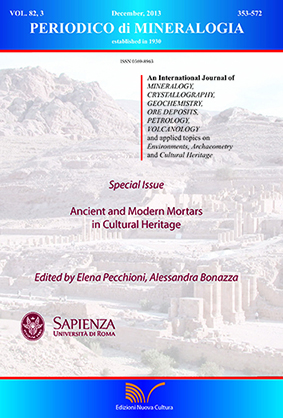Petrographic study of lime-based mortars and carbonate incrustation processes of mural paintings in Roman catacombs
DOI:
https://doi.org/10.2451/2013PM0030Keywords:
ancient mortars, mural paintings, lime, calcite, crystallisation, catacombsAbstract
The Roman catacombs of St Tecla, Domitilla and St Mark, Marcellian and Damasus located south of the centre of Rome were extensively investigated in this research, to study the technology of lime-based mortars and techniques of mural painting used by the ancient fossori to execute the decorated surfaces. The integrated minero-petrographic and microchemical approach exploited here and including thin section observations, X-ray diffraction analyses and diamond anvil cell FT-IR spectroscopy, provided evidence of the technical variability in terms of materials, mortar stratigraphy and application methods. Scientific data suggest potential environmental and operational explanations for certain technical solutions used by fossori in the second half of 4th - early 5th century AD. We also discuss a wide range of surface carbonate crystallisations, which represent one of the alteration processes affecting the inner surfaces in Roman catacombs, with direct impacts on the preservation and promotion of the painted heritage. The petrographic examination of the textural properties confirms that the morphologies with which the crystallisations occur depend on the hypogean microclimate of exposure. Strategies of preventive conservation should be based on long-term monitoring of the critical microclimate parameters, coupled with periodic diagnostics of the surfaces.


